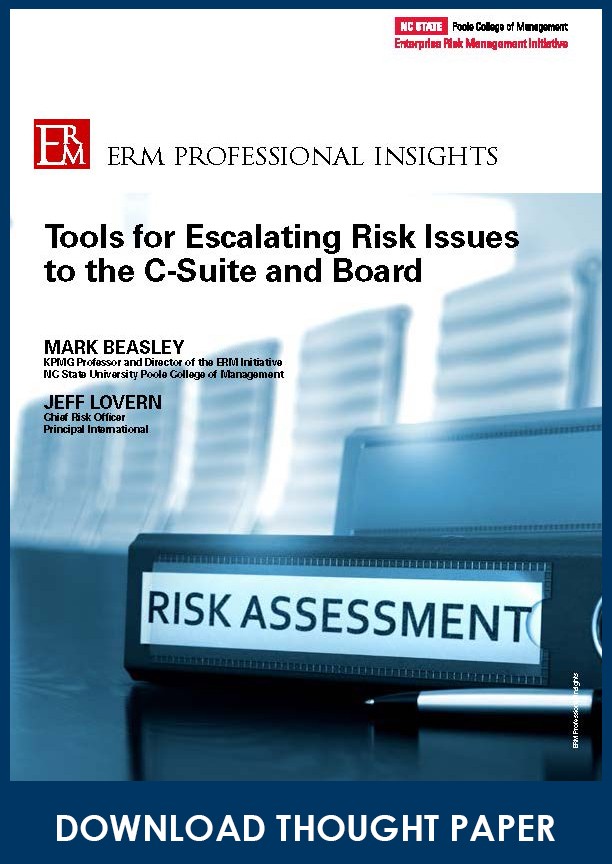Tools for Escalating Risk Issues to the C-Suite and Board
This thought paper, Tools for Escalating Risk Issues to the C-Suite and Board, by Mark Beasley and Jeff Lovern, provides a flexible tool/template to facilitate risk reporting to senior management and the board. The volume and complexities of risks on the horizon are at an all-time high. Not only are organizations navigating a multitude of risks triggered by the ongoing pandemic, but business leaders are also faced with numerous other significant events, such as implications from social unrest, the ongoing political elections, massive wildfires in the west and hurricanes in the east, volatility in economic markets, global trade tensions, and a fatigued work-from-home workforce, among other risk drivers. These developments are rapidly presenting a web of challenges that need the immediate attention of C-Suite executives and boards. This is compounded exponentially for organizations with global operations, given other emerging issues specific to local, regional, and national developments.
The challenge of monitoring these rapidly evolving issues can be daunting for C-Suite executives and boards. For many it may seem like they are in the middle of a “Perfect Storm.” Management may be struggling to merely “get their arms around” all the emerging risks, which seem to be on steroids, and they are likely hungry for simple tools that might help them quickly get up to speed on fast moving developments.
Rapid Risk Assessment Tool
Jeff Lovern, Chief Risk Officer at Principal International, recently shared an approach his team is using to gather information on emerging issues from key business leaders in the organization around the globe. His group has created a rapid risk assessment template for business unit leaders around the globe to complete when they identify new risk events that may warrant escalation to higher-level executives for further discussion and review. For this article, we developed an example of a generic template that any organization might find helpful (shown on the last page). Let’s briefly walk through the intended content.
High Level Overview: The goal of the one-page summary is to quickly capture as much information about an emerging event as soon as it is deemed relevant for escalation. The business unit leader provides a high level overview of the risk issue (i.e., the overarching concern) accompanied by two-to-three sentences that describe what is currently happening related to the risk event.
What We Know and Don’t Know: The template prompts the business unit leader to then provide insights about the facts surrounding the risk issue. For example, perhaps a government agency has just changed a recent policy or law that impacts immediately how an organization delivers a core service. The template captures all the known facts of the situation, and it also captures what remains uncertain. For example, the business unit leader may not know at this point how the government might penalize an organization for non-compliance with the new law. The business unit leader would also describe how the emerging risk event might impact the organization’s core business model (i.e., its products or services, its workforce, its access to capital, etc.) or impact strategic initiatives in the strategic plan (e.g., the organization’s planned product expansion may have to be temporarily halted until more clarity about the emerging law change is known).
Speed of What’s Driving Risk: Some risks escalate rapidly while others may be more gradual. The template prompts business unit leaders to document a sense for how fast conditions or other facts might change and what key factors might drive the change.
Keeping an Eye on Things: Now that the risk is on the radar, management would want to keep an eye on how the risk is trending and what conditions might cross a threshold that triggers further action and escalation. The template encourages business units to identify what internal or external data or qualitative information they are currently or should be monitoring to keep their focus on how the risk is shifting, including a sense for how it might be trending.
Current Responses: For some risks, the organization may already have responses in place to help prevent the risk from further escalating or they may have responses that might help mitigate the impact or consequences the risk may have on the organization. However, often the reason a business unit leader has identified the overarching risk concern is due to the fact that the business unit leader is concerned that the organization may not be adequately prepared to proactively manage the new emerging risk, which is why the business unit leader wants to escalate the issue for others to consider. The template prompts the business unit leader to suggest any thoughts and ideas for new risk responses that may warrant further consideration.
Fosters Conversation
The goal of the template is to provide a way to structure the sharing of high-level information about emerging risks. Some business unit leaders might be tempted to provide additional details beyond a single page or they may want to seek perfection in the information before it is shared. At this stage, the goal of the one-page risk profile is not perfection regarding the information. Rather, it’s about speed of escalation for further communication and dialogue with those higher up in the organization. Think of the onepager as a tool to quickly triage a situation. Those emergencies needing greater attention will be elevated for further discussion and information gathering while situations can be placed in a “watch list” category for further monitoring.
ERM leaders can obviously customize the template for what might be most relevant to their organization. This tool serves the purpose of helping rapidly escalate a risk issue. Management needs to accept that this document is always in draft mode and evolving. As the entity learns more about a given risk, the one pager may be updated with additional information to capture more details about the risks as it continues to unfold.
Some of the benefits a tool like this might provide include
- Encouraging management to quickly work together and articulate a unified position on a risk.
- Increasing the confidence among upper management that business leaders and risk management are on top of the matter, thinking about the right things and providing opportunities proactively for constructive questioning before executive management realizes an issue might be emerging.
- Positioning the ERM leader as the coordinator.
Thanks to Jeff for sharing the idea about this tool with us!
Original Article Source: “Tools for Escalating Risk Issues to the C-Suite and Board”, Mark S. Beasley and Jeff Lovern, NC State University ERM Initiative, December 2020
Download Thought Paper and Template
Download Word Version of Template Only
- Types:



